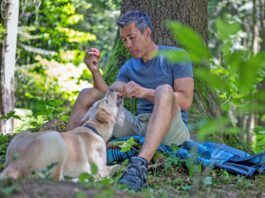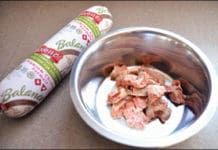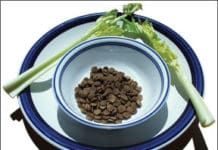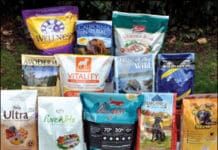Even More Frozen Raw Dog Food Manufacturer Information!
I love you, and I wonder if you even know how rare a publication like Whole Dog Journal is. On the same day that I got my Whole Dog Journal, I also got a professional “journal” issue reviewing medical research. Without exception, every article in that magazine was research sponsored by a company that made the product being evaluated. And, surprise! All the research showed wonderful results using their products! I am awestruck every time I read a review in WDJ and it is actual, objective information, not an infomercial.
How-To Books for Feeding Raw Diets
When someone becomes interested in feeding their dog a homemade diet, I always advise them to read at least one book on the subject before getting started. But which one should you choose? Guidelines run the gamut from diets that have been analyzed to ensure they are complete and balanced, to those that are dangerously inadequate. How do you tell the difference? I decided to check out the homemade diet books that are currently available. Some of them I’d read before, but wanted to take a fresh look at; others were new to me. It’s been an eye-opening experience.
Feeding People Food to Dogs is Not Harmful as Long as the Food is...
If you follow any pet-related blogs or other social media, the odds are you’ve heard of Nulo, a new company that has been marketing its foods aggressively through a variety of online channels. Nulo’s main thrust is that its foods and feeding programs will help your dogs reach and maintain a healthy weight – an admirable goal. Its foods are relatively high in protein (27 percent) with moderate amounts of fat (14 percent) and fiber (4 percent), appropriate for dogs who are overweight or who tend to gain weight easily. So I’ve had no objection to the marketing messages I’ve received from them (these messages were sent to members of one of the blogs I subscribe to).
Whole Dog Journal’s Commercial Frozen Raw Dog Food Review
The more I've learned about the meat used in pet food, the more I've come to admire commercially produced frozen raw diets for dogs. The meat and poultry used in most of these diets are far fresher and more wholesome - far more like what most of us would think of as "meat" - than most animal protein ingredients in dry (or even canned) pet foods. The products tend to produce terrific results in the dogs who consume them. Whether this is due to the ingredient quality or the fact that this type of diet is more biologically appropriate for canines than dry foods is anyone's guess. My guess is that both factors contribute to the success of the products.
Dog Breeders Who Only Feed Raw Dog Food Diets
You know you’ve been feeding raw for a long time when it no longer seems like a radical, ground-breaking, or – ubiquitous adjective for beginners – scary way to feed. When I started feeding raw – a dozen years and three generations of Rhodesian Ridgebacks ago – it was the Middle Ages of raw feeding. Ian Billinghurst’s Feed Your Dog a Bone was the hard-to-find illuminated manuscript (the lax editing could have stood some sprucing up by Benedictine monks), and everyone used the unfortunate acronym BARF, which stood for “bones and raw food” (or, later, the loftier-sounding “biologically appropriate raw food”). No commercial raw diets were available, and new converts dutifully ordered their Maverick sausage grinders over the Internet. The instruction booklet said the table-top grinder couldn’t be used on any bones harder than chicken necks or wings, but everyone ignored that.
AAHA to Create New Nutritional Guidelines
In January, the American Animal Hospital Association (AAHA) announced its plan to create a new set of nutritional guidelines for use by veterinarians and to publish these recommendations in June 2010.
Are Raw-Fed Dogs a Risk?
Delta Society is one of the largest and best-known organizations that registers and insures “pet therapy” volunteers and their companion animals. Pet/handler teams – known as Pet Partners – brighten lives in hospitals, nursing homes, group homes, schools, pre-kindergarten programs, libraries, jails, women’s shelters, homeless shelters, senior centers, adult day programs, and a host of other facilities. But on May 19, Delta Society triggered a firestorm of controversy, complete with conspiracy theories, angry denunciations, frustration, and confusion, when it announced that effective June 30, “any dog or cat from a household where raw protein food is fed is not eligible to be a Delta Society Pet Partner.” Delta’s Raw Protein Diet Policy raises serious questions about the safety of feeding raw food regardless of an animal’s pet-therapy status.
Using Your Dog’s Bowl As a Training Tool
You may think feeding your dog is a simple matter of dumping food in his bowl and plopping it down on the floor in front of him. You may be wrong. Mealtime is fraught with significance for your dog, and loaded with opportunities for you to influence his health and his behavior. Failure to take advantage of these could actually contribute to the development and/or escalation of problems that might otherwise be averted. A few deliberate decisions and choices on your part can go far in creating harmony in your home.
Problems With Artificial Preservatives in Dog Food
Recently we've heard from a number of dog owners who are concerned about the use of ethoxyquin to preserve fish meal that is used in dog foods. We've had one e-mail forwarded to us several times expressing worry over links between undeclared ethoxyquin in pet foods and canine cancer. We have long advised owners to pass over dog food that contains artificial preservatives such as butylated hydroxyanisole (BHA), butylated hydroxytoluene (BHT), tert-butyl hydroquinone (TBHQ), propyl gallate, and ethoxyquin, in favor of products made with natural preservatives, such as tocopherols (vitamin E), citric acid (vitamin C), and rosemary extract. Though synthetic preservatives were once as recently as 20 years ago the usual preservative found in all dry dog foods, today, they appear only on the labels of low-cost and lower-quality products.
HSUS Now Selling Vegetarian Dog Food
Earlier this year, the Humane Society of the United States (HSUS) entered the pet food market with its “Humane Choice” brand of organic vegetarian dog food. According to the product’s marketing materials, the impetus for the move was “to give pet guardians an option to feed their dogs a complete and balanced food that is also sustainably grown and helps us in our work to combat inhumane factory farm practices.”
Whole Dog Journal’s Dry Dog Food Review Update
Several of our eagle-eyed readers caught an error in dry dog food review in our February issue: “In the February 2010 issue, the picture of the approved dog foods includes Nutro Ultra but it is not listed in the article. Why the discrepancy?” “I see that Nutro Ultra is included in the photo on page 3; its caption says ‘these are just a few examples of premium quality foods.’ However, it’s not included on the ‘approved foods’ list. Can you clarify?” “I noticed that the Nutro Ultra Holistic food is in your picture, but I couldn’t find it in the actual list of approved foods. Is it one of the approved foods?”
Whole Dog Journal’s 2010 Dry Dog Food Review
Here is Whole Dog Journal's Approved Dry Dog Foods List for 2010. All these products meet our selection criteria - including our newest criterion, that the company discloses the name and location of its manufacturers. Today's dog owners have more and more choices of better-quality foods including many featuring organic or "wild" ingredients.

















